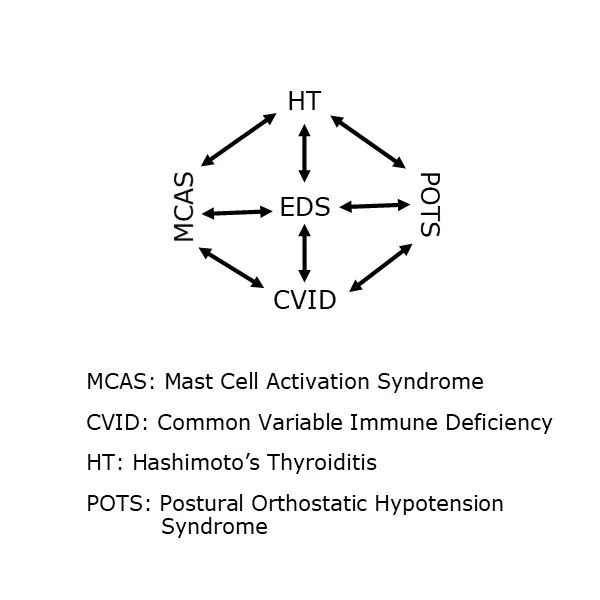Ehlers-Danlos Syndrome (EDS)
EDS is one of the most disabling disorders known to humankind, affecting over 3 million people worldwide.
Stability for the Unstable. Care for the Overlooked.
At Muscle & Joint Clinic, we understand the complexity of living with Ehlers-Danlos Syndrome. Our expert team is committed to providing specialized, compassionate care designed to relieve your pain, enhance your function, and significantly improve your quality of life.
Our clinic proudly offers a 14-week comprehensive residential treatment program specifically designed for patients with EDS. This innovative and integrative approach has been recognized as one of the best in the world by the Ehlers-Danlos Society (learn more about designation criteria). Our multidisciplinary program addresses the most significant imalances that occur with eDS:
Physical: Personalized physical therapy, chiropractic adjustments, strengthening exercises, and joint stabilization techniques.
Chemical: Nutritional counseling, targeted supplementation, gut-health restoration, and inflammation management to support optimal health.
Emotional: Emotional support, stress management strategies, mindfulness training, and psychological counseling to enhance emotional resilience and well-being.
Why Choose Muscle & Joint Clinic for Your EDS Treatment?
-
We are science-based, compassion-driven.
-
Internationally recognized 14-week residential treatment program.
-
Holistic approach addressing the 3 pillars of health: physical, chemical, and emotional systems of the body.
-
Highly experienced specialists committed to your recovery and wellness.
-
Conveniently located in San Rafael, CA.
- SFO – 1 hour
- OAK – 45 minutes
- STS – 45 minutes
- NAS – 15 minutes
Understanding Ehlers-Danlos Syndrome (EDS)
EDS affects the body’s collagen production, leading to joint hypermobility, chronic pain, frequent injuries, and a range of systemic health issues. While symptoms vary among individuals, many experience persistent joint instability, muscle pain, fatigue, and emotional distress, which can significantly impact daily life and activities. Often, other disorders are experienced with EDS, such as POTS, MCAS, CVID, Generalized Anxiety Disorder (GAD), and PTSD.
What Causes Ehlers-Danlos Syndrome?
Ehlers-Danlos Syndrome, also referred to as EDS, weakens the connective tissue in the body. Ehlers-Danlos Syndrome is inherited. EDS affects the body very differently from person to person. Each person’s experience is their own and is likely to not be the same as someone else’s. Loose joints, hypermobility, abnormally smooth skin, and easy bruising characterize the common symptoms.
Many people with EDS are affected by other syndromes which are tightly intertwined. The diagram illustrates some EDS-related disorders. Ehlers-Danlos Syndrome is complex. Having bendy joints is just one aspect of what EDS encompasses. It affects the intestines, blood-brain barrier, ligaments that hold organs in place… the list can be very long.
Why Ehlers-Danlos Syndrome Is So Difficult to Diagnose
Ehlers-Danlos Syndrome (EDS) is a group of inherited connective tissue disorders that affect collagen, the protein responsible for providing structure and strength to skin, joints, and blood vessels. While EDS can be painful and disabling, it often goes undiagnosed or misdiagnosed for years—especially in its most common form, hypermobile Ehlers-Danlos Syndrome (hEDS).
1. Wide Range of Symptoms
EDS affects multiple systems in the body and presents with a broad spectrum of symptoms, including:
Chronic joint pain and instability
Frequent dislocations and sprains
Digestive issues (Gastroparesis and MCAS)
Chronic fatigue (CFS
Autonomic dysfunction (e.g. POTS)
Fragile skin or bruising
These symptoms can overlap with other conditions like fibromyalgia, chronic fatigue syndrome, or autoimmune disorders—leading to frequent misdiagnosis.
2. No Genetic Test for hEDS
Unlike some subtypes (like vascular EDS or classical EDS), hypermobile EDS has no definitive genetic marker. Diagnosis is based entirely on clinical criteria, which can vary from provider to provider and is often missed by those unfamiliar with connective tissue disorders. Hypermobile EDS accounts for an estimated 90% of Ehlers-Danlos Syndrome cases. The US FDA is currently reviewing approval of the genetic marker for hEDS, which we promptly integrate into our diagnosis and care.
3. Invisible Symptoms
Many individuals with EDS appear outwardly healthy. Since symptoms like joint pain, fatigue, and dizziness are often “invisible,” they are frequently dismissed by healthcare providers, further delaying accurate diagnosis.
4. Lack of Awareness Among Providers
EDS is still considered a rare condition by the International Classification Of Diseases. Therefore, many general practitioners and specialists are not trained to recognize its signs, especially when symptoms involve multiple systems. As a result, patients often see multiple doctors, sometimes dozens, over several years before receiving an accurate diagnosis. Besides the frustration of finding a proper diagnosis and effective treatment, people are often told that their symptoms are psychosomatic, that they are really okay because all of the labs, tests, and imaging didn’t find anything. This process often causes mental illness or worsens underlying anxiety or PTSD.
5. Highly Variable Presentation
Two patients with EDS may have entirely different symptom profiles. One may struggle with daily dislocations, while another primarily suffers from gastrointestinal or cardiovascular issues. This variability makes standardized diagnosis more difficult, even among specialists.
Treatment
Muscle & Joint Clinic is a world leader in treating Ehlers-Danlos Syndrome. With our years of experience treating EDS, our background is unparalleled. We don’t predetermine what your care is going to be. Treatment is tailored to each person’s needs following an exam. Most often, treatment is a combination of in-office and home-based therapy. Muscle & Joint Clinic will closely monitor your progress, modifying it as your body restores its strength and capacity.
While Ehlers-Danlos Syndrome is not curable, Muscle & Joint Clinic’s proven track record has allowed many of our patients to reduce pain and increase function. We have helped patients devastated by pain, joint instability, and other aspects of EDS. We work with you to find the best way to develop a pain-reduced or pain-free lifestyle. Many people who live with EDS have learned with proper treatment they can still be active and do the things they love.
Contact us to schedule an appointment or learn more.

The Bendy Body Foundation is a 501(c)3 non-profit organization with a mission to increase accessibility and understanding of Ehlers-Danlos Syndrome
Apply today to see if you qualify for assistance by contacting Muscle & Joint Clinic.
Expert care for a condition that demands more than a one-size-fits-all approach.
At Muscle & Joint Clinic, we’re trained & experienced to recognize & treat the full spectrum of EDS challenges—because you deserve clarity, support, and relief.
Call today to get your free consultation with Dr. Derik Anderson to help determine your best path to a better life, 415.488.5372&

